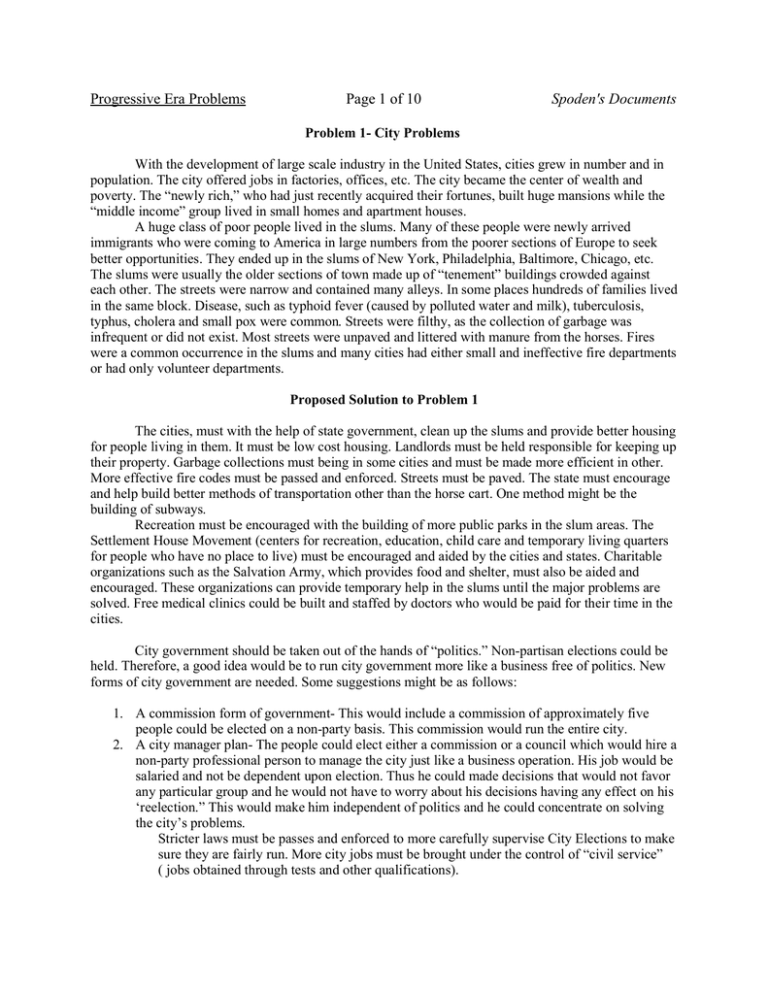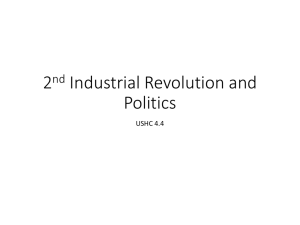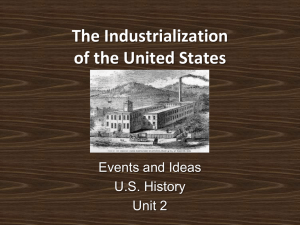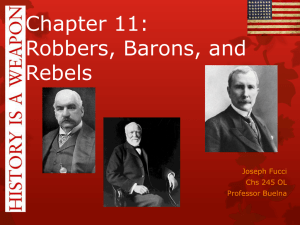Progressive Era Problems Page 1 of 10 Spoden's Documents
advertisement

Progressive Era Problems Page 1 of 10 Spoden's Documents Problem 1- City Problems With the development of large scale industry in the United States, cities grew in number and in population. The city offered jobs in factories, offices, etc. The city became the center of wealth and poverty. The “newly rich,” who had just recently acquired their fortunes, built huge mansions while the “middle income” group lived in small homes and apartment houses. A huge class of poor people lived in the slums. Many of these people were newly arrived immigrants who were coming to America in large numbers from the poorer sections of Europe to seek better opportunities. They ended up in the slums of New York, Philadelphia, Baltimore, Chicago, etc. The slums were usually the older sections of town made up of “tenement” buildings crowded against each other. The streets were narrow and contained many alleys. In some places hundreds of families lived in the same block. Disease, such as typhoid fever (caused by polluted water and milk), tuberculosis, typhus, cholera and small pox were common. Streets were filthy, as the collection of garbage was infrequent or did not exist. Most streets were unpaved and littered with manure from the horses. Fires were a common occurrence in the slums and many cities had either small and ineffective fire departments or had only volunteer departments. Proposed Solution to Problem 1 The cities, must with the help of state government, clean up the slums and provide better housing for people living in them. It must be low cost housing. Landlords must be held responsible for keeping up their property. Garbage collections must being in some cities and must be made more efficient in other. More effective fire codes must be passed and enforced. Streets must be paved. The state must encourage and help build better methods of transportation other than the horse cart. One method might be the building of subways. Recreation must be encouraged with the building of more public parks in the slum areas. The Settlement House Movement (centers for recreation, education, child care and temporary living quarters for people who have no place to live) must be encouraged and aided by the cities and states. Charitable organizations such as the Salvation Army, which provides food and shelter, must also be aided and encouraged. These organizations can provide temporary help in the slums until the major problems are solved. Free medical clinics could be built and staffed by doctors who would be paid for their time in the cities. City government should be taken out of the hands of “politics.” Non-partisan elections could be held. Therefore, a good idea would be to run city government more like a business free of politics. New forms of city government are needed. Some suggestions might be as follows: 1. A commission form of government- This would include a commission of approximately five people could be elected on a non-party basis. This commission would run the entire city. 2. A city manager plan- The people could elect either a commission or a council which would hire a non-party professional person to manage the city just like a business operation. His job would be salaried and not be dependent upon election. Thus he could made decisions that would not favor any particular group and he would not have to worry about his decisions having any effect on his ‘reelection.” This would make him independent of politics and he could concentrate on solving the city’s problems. Stricter laws must be passes and enforced to more carefully supervise City Elections to make sure they are fairly run. More city jobs must be brought under the control of “civil service” ( jobs obtained through tests and other qualifications). Progressive Era Problems Page 2 of 10 Spoden's Documents Problem 2- Labor Problems With the rise of the “big business” and huge factories, more and more people, including women and children began working for large companies. The relationship between employers and employees became more and more impersonal since the owner usually did not know his employees personally. Working hours were very long, usually 10-14 hours a day, 6 to 7 days a week. Wages were very low with little or not pay for overtime and few if any vacations or days off. Working conditions were quite often unhealthy and unsafe as employees had little protection. The mining industry was one of the worst examples. If an injury occurred on the job it was necessary for the employee to prove that the employer was negligent and this usually involved going to court, which most employees could not afford. Some workers began to join together to form unions and began strikes against unfavorable working conditions, hours, wages, etc. However, most of these strikes were unsuccessful as employers refused to recognized unions and fought back with their own methods, lockouts, hiring strikebreakers, etc. In addition, it was easy for employers to replace striking employees because a huge supply of available workers, especially new immigrants, existed. Besides this, government mostly sided with big business an thus courts and government leaders would order the police, and sometimes troops to break up the strikes. With the failure of many strikes and the slow progress of early labor unions, some workers began to listen to and join more radical groups which were preaching violence as the only way for workers to achieve their rights. Whenever violence resulted during a conflict, the unions lost even more support as the general public reacted unfavorably toward violence. Unions were then blamed for causing most of the trouble. Proposed solution to problem 2 The government should be neutral in labor disputes. A law should be passed giving unions the right to exist. Laws should be passed to allow unions to strike, boycott and picket peacefully. These laws could be started at the state level and thus give encouragement to the federal government to pass nation-wide laws of this type. The city and state governments should set standards by giving their workers 8 hour days and better working conditions. Laws should be passed prohibiting children under 14 years of age from working state contracts should not be given to companies that work their employees more than 8 hours. A State Department of Labor should be created to investigate working conditions and a State Department of Mines should be created to look into control unsafe and unhealthy conditions in the mining industry. A state workman’s compensation law should be passed to make employers responsible for providing insurance for work connected injuries. The federal government should be urged to do the same thing for their employees. This would serve as an example to all states. Finally, state leaders in government should work to urge members for congress to pass a law restricting the number of immigrants allowed into the United States so that employees could not so easily hire as many new immigrants and pay them low salaries. Progressive Era Problems Page 3 of 10 Spoden's Documents Problem 3—Monopolies and Business Excesses With the growth of industry in the United States American businessmen began to join together to form huge companies. Large companies had an advantage over small ones in being able to expand and produce goods at a cheaper cost. While the public did gain from the rapid expansion of industry, through the variety of new products available to them, business “combinations” gained so much power that they could drive small competitors completely out of business. Businessmen used such methods as price fixing, underselling, and making deals with railroads to force their competitors out of business. Through various means such as forming pools (agreeing to divide the market to fix prices) and trusts (combining companies into larger ones) more and more industries were controlled by giant companies. During the 1880’s such industries as oil, steel, railroads, sugar refining, mean packing, chemicals, etc., came under the control of these giant companies. This led to monopolies or near monopolies. Certain industries needed to be monopolies in order to function, such as water, gas, electricity, etc. However these natural monopolies, known as public utilities, gained enormous power which resulted in huge profits for them. A monopoly obviously eliminated all competition and thus could easily raise prices and produce whatever quality goods it desired. These huge enterprises gained so much power that they could influence government officials to pass laws favorable to their interests. Proposed Solution to Problem 3 Laws should be passed to outlaw companies which become so powerful that they control their industry completely. This should b an effective law that defines what a monopoly is and gives government officials the power to break monopolies. The state government (through the state attorney general) should bring suits in court to up trusts especially those that used unfair methods to drive out competitors. These suits would have to be aimed at corporations that operate only in this state. However state leaders should urge the federal government to break up the big trusts that are operating nationwide. A state department of commerce should be formed, which would include a bureau of corporations that operate only in this state. The state should pass laws to forbid such unfair methods as price fixing, trying contracts, interlocking directories and the purchasing of stock from other companies when the goal is to forum a monopoly. The federal government should be urged to do these same things, since so many corporations are nationwide. The state should set up (and urge the federal government to do likewise) a commission that has the power to regulate (control) industries. This commission could require business to provide earnings recorded at the end of the year. The commission could have investigate the activities of corporations and publish the results of their investigation. The commission could order corporations to stop unfair methods of competition. If a commission got into a dispute between itself and a business it could be settled in court. Finally public utilities such as water, electricity, and gas, which are “natural monopolies”, should be brought under the direct control of the state, or operated directly by the cities. A public utility commission should be formed to set rates and prices for these businesses. Progressive Era Problems Page 4 of 10 Spoden's Documents Problem 4 – The Consumer With the growth of industry in the United States the method of producing food products changed a great deal. Before the industrial revolution most Americans either grew and produced their own food or they obtained it from a neighbor or local small store. Preserving food was difficult, even though some people had a spring or maybe an ice house. Meat, for example, was usually purchased shortly after a cow, chicken, etc., had been slaughtered. Since it was difficult to preserve most foods (with some exceptions) they were either consumed shortly after they were harvested or later consumed as dried foods. With the growth of cities the demand for large quantities of food products increased. Many huge companies began to produce food products on a mass production basis. Since many businesses were monopolies or near monopolies, the public had to buy their products. Since many food products had to be shipped long distances from farm to city areas, and thus were packaged in large quantites for the first time, some methods had to be devised to insure that food products could preserved for long periods. Food manufacturers, therefore, hired chemists to develop chemicals that would preserve food for longer periods of time. Numerous chemicals were added to foods to keep them from spoiling. There were few laws controlling the preparation of food products, thus manufacturers began to use chemicals for all sorts of advantages. In addition to preservatives, dyes were added to food that had already spoiled to conceal their decomposition. They were also used to make food more appealing. Chemicals were used to hide bad odors or to give the scent of freshness. Thus, many food products were being adulterated (made impure). Studies showed, for example, that alum was added to bread, milk was preserved with small amounts of formaldehyde, boric acid and borax, coffee was colored with various dyes and butter contained coal tar dye, as did numerous other products such as sausages, vinegar and catsup. These are only a few examples, however the main problem was that little, if any knowledge, was known about the effect of these chemicals on the human body. The meat packing industry was particularly bad because of its unsanitary practices. Meat was sometimes prepared form diseased animals even though government inspectors were supposed to check the animals before they went through the plant. A study by a government commission showed that meat was shoveled from filthy floors to rarely washed tables and in its transfer from room to room, it gathered all sorts of dirt including splinters and other items. Since the law only required animals to be examined and not the entire process of meat preparation, packers were free to do what they wanted. Drugs and “patent medicines” often contained harmful ingredients. Drugs could contain such dangerous items as opium and morphine without any indication to the consumer. There were no requirements that bottles specify the exact contents. Quite often false or misleading statements, both on the bottle and in advertising, made claims that these medicines could cure all sorts of diseases. Quite often patent medicines contained only a small percentage of an actual product that was claimed. Proposed Solution to Problem 4 Progressive Era Problems Page 5 of 10 Spoden's Documents The public must get the state legislature to pass more state laws that require foods and medicines to be pure and safe. Since a great number of products go from state to state, a great effort should be made to get Congress to pass a federal pure food and drug law. State officials, state chemists, etc., should send letters and make personal appeals to get this nationwide law passed. The law should forbid the use of chemicals in food products that are harmful or the manufacture of drugs that are dangerous. The law should also require that all medicines be required to have a label which states the exact contents and amounts of each ingredient. It should also be illegal to sue flase or misleading advertising and labels. A law should also be passed requiring the complete inspection of meat through every process of preparation. Once again, since a great deal of meat goes from state to state, leaders in your state should actively participate in pressuring the federal government to pass a nationwide law. *A great deal of the source material for this problem was obtained from Our Times, America Finds Herself by Mark Sullivan, which was published in 1927. The chapter on “The Crusade for Pure Food” is an excellent description of the problem as it existed in the early 1900’s. Problem 5 – Conservation For many years people thought of the environment (land, rivers, forests, mineral resources) as something to conquer and make use of to the fullest extent. The idea that our resources were limited was generally not thought of as Americans believed we had a vast supply in our country, especially in the frontier. Over the years our forest lands were steadily being cut down. By 1900 only 200,000 acres out of an original 800,000 acres were left. Our rich soil was beign used extensively. Mineral deposits, especially coal, were being taken out without any regard for the surrounding area. Hydraulic mining was among the worst examples. Oil fields were being developed while natural gas was being allowed to escape without any concern. There was hardly any thought of “pollution” as industrial dyes and other waste materials were being dumped into nearby rivers and streams. Wildlife preservation was not considered very important. In addition, the environment in which wildlife lived was not being preserved. As the population grew and industry expanded, more resources were being used. A few attempts had been made to save some of our timber lands with the establishment of the National Forest Bureau, which gave the President of the U.S. power to withdraw timberlands from sale. Some land had been set aside as national parks and states had established a few state parks. However the general public did not yet think of conservation in any serious way. Progressive Era Problems Page 6 of 10 Spoden's Documents Proposed Solution to Problem 5 The first thing that is needed is to awaken the public to the need for conservation of our natural resources. Conservation must be made “popular”. Our state Governor should be sent along with other governors to Washington, D.C. to meet with the President in a nationwide conference on conservation. This conference could include scientists, newspapermen, and other government leaders. The discussions at the conference should be dramatized in the newspapers and in speeches by government leaders. Our state governor should meet with nearby state governors, whose state resources are shared (forest and mineral resources, lakes, rivers, etc.) and discuss common problems. A state commission should be formed to study the resources of the state. The State should create more state parks and wildlife sanctuaries. More land owned by the state should be withdrawn from sale. State reclamation projects should be given high priority. The federal government should be urged to aid and encourage these projects and to create more national parks. The federal government should also be urged to create a nationwide commission to study all resources in the United States. Finally, state laws should be passed regulating the use of public lands, forests, rivers, etc. Wildlife in the state such as animals, fish and birds should be protected as much as possible. State departments of fish and game should strictly enforce hunting and fishing regulations established in the laws. Problem 6 – Women’s Rights For several years women had been denied equal rights in many aspects of American life. A women’s rights convention had been held as early as 18448 to publicize many of the inequalities. During the next 50 years some progress was made in giving women equal rights, especially the passing of laws and the decisions of courts regarding the personal and property rights of married women. Before this time, the legal rights of married women were very limited as they could not sue in courts, make contracts, own property from the marriage, or even have any legal claim to their children/ Most states had corrected these legal inequalities of married women by 1900, however the leaders of the women’s rights movement strongly felt that if women could achieve the right to vote many of the other inequalities could be corrected/ they felt that if women could vote they could influence laws by their direct control over who got elected for public office. In addition, women themselves could then qualify for public office. In 1900 there were a few states such as Wyoming that had begun to grant women the right to vote, however most states denied them the right to vote. In addition, women were not allowed to serve on juries. Your state is one of the states that does not allow women to vote nor does it allow them to serve on juries. Progressive Era Problems Page 7 of 10 Spoden's Documents Proposed Solution to Problem 6 To start with your sate must include an amendment in its constitution granting women the right to vote. After this is done government leaders in your state must urge the adoption of an amendment to the U.S. Constitution granting women the right to vote throughout all the states. State laws should be passed allowing women to serve on juries. Women should be encourage to enter professional fields and this can be done by having state colleges and universities actively recruit women for education in these fields. The state government should grant special funds to colleges and universities for this purpose. School districts throughout the state should be forced to pay women teachers the same wages as men for similar teaching positions. Women should be given the opportunity to run for political office and to enter the field of public service. Since the legal profession is most often the first step to political office, law schools should be opened up to women and the state should help develop special programs in these schools. In addition, women judges should be appointed by the governor and by city mayors. Problem 7 – the Farm Problem Until the late 1800’s American farmers were considered the backbone of American Society. Farmers still represented approximately 50% of the population in 1900. with the growth of industry farmers began to use the new machinery available to specialize in certain crops such as wheat, corn, etc. As railroads became nationwide more and more farmers began to sell these “specialty crops” to faraway markets. Thus they became more dependent on business to provide the machinery and the railroads for transportations. As farmers began to specialize more and more they began to overproduce their crops and the market became overloaded. Thus farm prices began to fall and as they did more farmers began to fall into debt. They began to borrow more and more money to meet their debts. Unfortunately, interest rates for borrowing money were very high as lenders took advantage of the situation. More and more farms became mortgaged to the bank. Some of the farmers’ problems were caused by the increasing cost of transportation, middlemen who stored and later sold the goods, and express companies that delivered packages and farm equipment. At that time all packages had to be sent through private companies, as the Post Office only carried letters. Transportation costs were the most serious problems as railroads favored large customers (oil companies, etc.) over small ones. Railroads granted rebates (refunds) to certain large companies in order to gain business. They made up for this by charging higher rates to small customers. In addition, railroads often charged more for short hauls than for long ones. This was because in areas where railroads were competing with each other, they had to keep their rates reasonably low. To make up for this, however, they charged higher rates in farm areas where they were the only railroad operating, even though they were hauling for shorter distances. Thus railroads in many states began to have an enormous influence over the income of farmers. Progressive Era Problems Page 8 of 10 Spoden's Documents Farmers formed their own organization, such as the “Grange,” and farmers cooperatives/ finally they began to elect representatives to state legislatures and even to the U.S Congress. In some states they were able to get laws passes to help them. Commissions were created to investigate railroad practices and to control some of their activities. Some of these commissions were even given the power to set maximum freight rates. However, after a series of decisions the U.S Supreme Court finally ruled in 1886 that states could not regulate railroads, this was a power reserved only for the Federal Government. Due to this ruling farmers worked for and got the Interstate Commerce Act passed by Congress, which outlawed many of the unfair practices mentioned above. This act also created a commission known as the Interstate Commerce Commission, which was given the power to investigate the practices and financial records of railroads. However, the Commissions was not very powerful in that it could not set railroad rates. Unfortunately, the railroads got around this act and continued to use unfair practices. Finally the farmers organized a political party of their own- The Populist Party. They put most of their efforts into the election of 1896, which they lost. In this election they concentrated on another issue, the money supply, which they blamed for their falling farm prices. For more complete explanation of this issue, see Problem 10. Proposed Solution for Problem 7 The state and federal government must step in to help the farmer. State leaders must urge and use all the pressure they can to get Congress to pass a law increasing the power of the Interstate Commerce Commission. This Commission should have the power to strongly regulate railroads and to set maximum freight rates. It should also be give the power to regulate express companies. Both the state and federal government must provide cheap (low interest) loans to farmers to help them back on their feet again. The state and federal government must spend money for agricultural education and for vocational training programs to provide jobs for displaced farmers and their children. Finally, the state leaders must urge Congress to pass a law allowing the U.S. Pot Office to carry packages at reasonable rates. Problem 8 – Corruption in Government Ever since the end of the Civil War government in the United States became more influenced by “special interest” groups. These groups sought to influence lawmaking by applying numerous “pressures” on people who held elective offices. Big business was the strongest of these groups as government became more and more under its influence and control. Many politicians took bribes from special groups or they received money in the form of “campaign contributions.” Politicians at every level of government, local, state and national, were controlled by party leaders. The party leaders determined the nominees for each party. The party leaders made most of the decisions “behind the scenes.” U.S. senators were selected by state legislatures, and thus state political leaders exercised complete control over the national government in that way. The elected representatives as far up as the President had to be very concerned with their party’s wishes if they desired to receive continued support in the next Progressive Era Problems Page 9 of 10 Spoden's Documents election. Many elected officials gave a great deal of consideration to how a decision or vote they made might affect their chances of reelection. Election frauds were common as people voted in public. Just about anyone could see the way a person voted as ballots of each party were different colors. In addition, many times ballots were too long as they made it necessary for the voters to decide on numerous elective offices. Thus the average person could not give a great deal if thought to how he voted. Sometimes people merely voted for all the candidates of their favorite party as this seemed the easiest way to decide. Many government jobs were still under the control of elected officials. Mayors, governors, the President, etc., would appoint or give most jobs to supporters. This was known as the spoils system. Some of the worst aspects of this system were being corrected at all levels of government. At the federal level the Pendleton Act of 1883 had given the President power to place more federal jobs under civil service. This meant jobs were obtained by qualifications and tests. At the state level civil service commissions had been created to set up qualifications and tests for jobs in state government. Unfortunately, many jobs at all levels of government were still appointive. Proposed Solution to Problem 8 The problem must be solved primarily by giving the people more control over their government. To start with, voters must have more say so in determining which candidates will be nominated for the major parties. Primary elections both for state positions and for federal positions must be held before the party conventions. These elections would allow candidates to sound out the wishes of the people rather than just the wishes of the party leaders. Candidates who win primaries should be given a greater chance of obtaining nominations. State and local leaders who are going completely against the people’s wishes could be removed from office. Thus a recall election could be held if a certain percentage of people sighed a petition for it. Laws that were being “snuck” through the state legislature to favor special interests groups should be considered by voters of the state. A referendum (vote by the people) could be held on the law if a certain percent of people signed a petition for it. Laws that the people wanted for themselves could be placed before the legislature or be put in a ballot by an initiative (petition) signed by a certain percent of people. State leaders should urge the passing of a constitutional amendment to allow the people in all the states to vote directly for their own senators. Very serious consideration should be given to having a single term presidency. Thus, the President could make decisions without the pressure of reelection in front of him. Political parties should be required to make public where they received their financial support. Voting should be conducted by secret ballot. Less state and city positions should be elective. Instead only a few important public offices should be elective. Thus a ballot would be shorter and people would be able to concentrate on voting for these positions. The previous elected positions could be placed under the control of the top elective officers or placed under civil service. The state government should place more jobs under civil service where it is necessary to be qualified and pass tests. This should also be done at the national level of government. Progressive Era Problems Page 10 of 10 Spoden's Documents Problem 9 – Inequality in the Distribution of Wealth The growth of industry in the United States caused a tremendous gap between the income of a few thousand millionaires and the rest of the population. It was estimated that by 1900 on percent of the population owned about 50% of the wealth, and in addition, that about half of the population owned hardly anything.* Even though these were only estimates, there was little doubt that a huge gap existed between the rich and the poor. While the middle class was growing in numbers, so was the very poor class. The gap began to grow as the rich got richer and the poor got poorer. The “newly rich” began to build huge mansions which were decorated with expensive furniture and art objects while the poor lived in run down tenements. The rich spent their spare time on their own boats, railroad cars, horses, etc., and gave many parties that sometimes cost hundreds of dollars for one night. The poor, on the other hand, could barely afford to provide their families with food, shelter and clothing. Most middle and low class families could not afford to educate their children as completely as the rich upper class families could. In many areas, especially the big cities, free public education was now being provided through the 12th grade. However, there were still numerous areas, such as the small towns and farming communities (especially in the South) that did not provide free public education beyond elementary school, and many of the schools only ran 3 to 4 months of the year. At this time nearly half the population still lived in small towns and farming communities. Many middle class families were able to let their children complete 12 years of school, while large numbers of poor families could not afford to have their children continue beyond elementary school. These children were needed to help earn money for the family by working in the city factories or on the country farms. Besides, most high schools still strongly emphasized highly academic subjects which were intended to prepare students for higher learning. The rich usually sent their children to private academies and later to colleges and universities. Thus, with more education, the children of the rich were better qualified to succeed while in many cases children of the lower and middle class were at a disadvantage. Many of the children of the poor remained illiterate (unable to read and write). Proposed Solution to Problem 9 The state and federal government must begin to narrow the gap between the very rich and the middle and low income groups. This can be done by making some efforts to reduce the growing income of the rich and to try and help the poor raise their income level. The first thing that is needed is a graduated (the more you make the more you pay) income tax. This can be done at the state and national level. This may require an amendment to the Constitution. The next thing that is needed is a higher and more effective tax on corporations. Finally, there must be higher inheritance taxes in each state. In addition to this, states should actively urge rich individuals to donate money to charitable and educational programs. The second thing that is needed is an attempt to bring up the educational level of the lower and middle classes. The state must encourage and aid those local areas that do not provide free public education beyond elementary school. All areas must have free public high schools and laws should be passed to require children to attend school at least to age 16. finally, subjects in high school must be more practical instead of only academic. More high schools should offer such subjects as shop, bookkeeping, typing, business math, home economics, etc., to help train young people for good jobs. State colleges and universities must offer more programs in science and industry. *Source – “Arena,” August, 1901, citied in John D. Hicks, The American Nation, 1968





